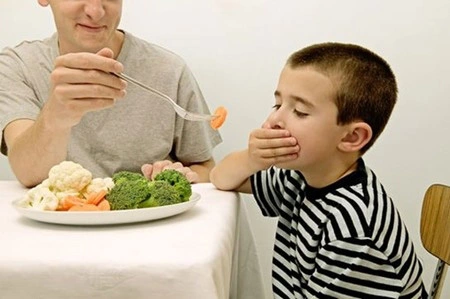1. What is anorexia nervosa in children?
Anorexia nervosa is a disorder in which a person restricts food intake relative to their energy needs by eating less, exercising more, and/or purging food through laxatives and vomiting. Children and adolescents with this disorder have a distorted view of their body shape, such as thinking they are too fat, actively trying to lose weight, and maintaining a lower than ideal weight.

2. Why do children show signs of anorexia nervosa?
The exact cause of anorexia nervosa is unknown. Like many other illnesses, it is likely a combination of biological, psychological and environmental factors.
The main factors that cause anorexia nervosa are:
- Social bias towards body shape: thinness is preferred.
- History of body teasing: children who are teased or bullied about their weight are more likely to develop an eating disorder. These teasing can be friends, family members, teachers, etc.
- Family history: children with anorexia often come from families with a history of:
- Weight problems.
- Medical problems.
- Other mental health problems such as depression or substance abuse.
3. Which children are at risk for anorexia nervosa?
Most children with anorexia nervosa are girls, but boys are increasingly being diagnosed with the condition. It used to be more common in middle- and upper-class families, but is now being seen in all socioeconomic groups, as well as many ethnic and racial groups.
Children with anorexia often come from homes with rigid and critical parents. These parents tend to be intrusive and overprotective, while the child is emotionally dependent and immature. The child may also have other mental health problems, such as anxiety disorders and depression.
4. Symptoms of anorexia nervosa in children
Symptoms vary from child to child. Children may:
- Losing a lot of weight: more than 15% of body weight.
- Fear of being obese, even if the child’s weight is lighter than the standard.
- Refusing energy-rich foods: meat, fat, eggs, fish, etc.
- Denying hunger to reduce the amount of food: always saying full or eating quickly, etc.
- Doing a lot of physical activity to speed up weight loss.
- Becoming withdrawn, irritable, moody or depressed.
Many of the accompanying physical symptoms associated with anorexia nervosa are often the result of malnutrition:
- Dry, peeling skin.
- Abdominal pain.
- Constipation.
- Tired, lethargic.
- Feeling colder than usual.
- Development of fine hair on the body.
- Jaundice.
- Subcutaneous bleeding.
- Edema.
- In girls, missing 3 menstrual periods without any other cause.

5. How is anorexia nervosa diagnosed and treated in children?
Parents, teachers or caregivers can detect signs of anorexia nervosa in children or adolescents, although many children tend to hide their symptoms.
The doctor will conduct a physical examination and perform a number of tests: blood tests, cardiovascular tests, nutritional assessment, psychological tests, etc.
Treatment will depend on the symptoms, age, general health of the child and the severity of the condition. The child will receive psychological therapy to correct the distorted perception of body shape, restore nutrition, and use medication to adjust accompanying emotional and behavioral problems in some cases if necessary.
Anorexia nervosa is a disease that can cause serious health problems, even leading to death. Therefore, early detection and timely intervention are needed to limit the consequences.





